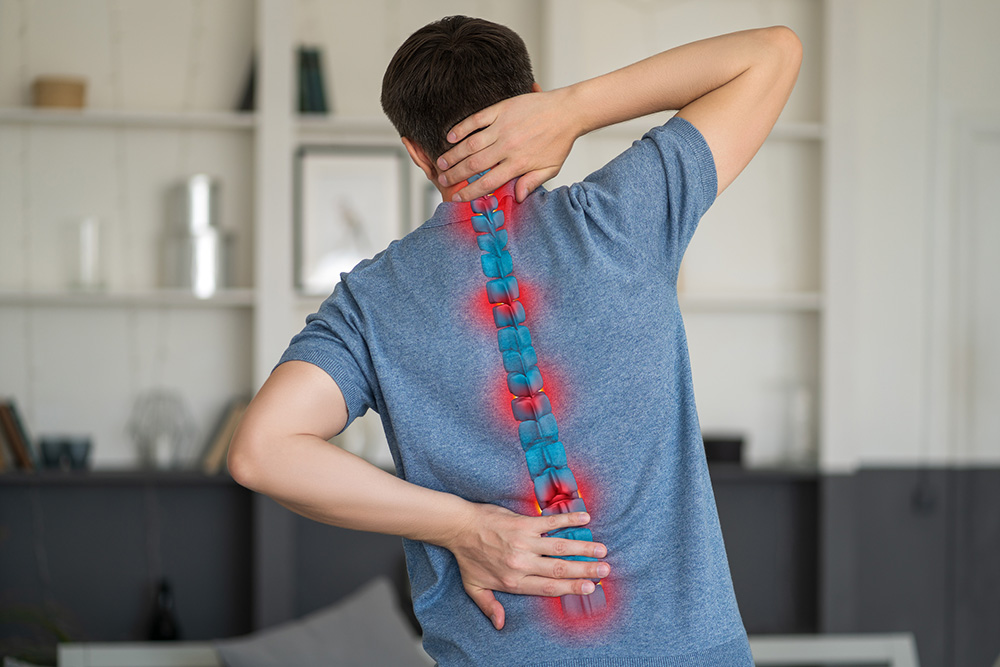
Disc herniation, often colloquially referred to as a “slipped disc,” is a common condition that affects millions of people worldwide. Understanding the science behind disc herniation involves delving into the anatomy of the spine, the mechanisms leading to herniation, and the various risk factors that contribute to this painful condition.
Anatomy of the Spine
The human spine is a complex structure composed of vertebrae, intervertebral discs, nerves, and supporting muscles and ligaments. The intervertebral discs are crucial for providing flexibility and shock absorption. Each disc consists of two main parts:
Nucleus Pulposus: The soft, gel-like centre.
Annulus Fibrosus: The tough, outer ring of fibrous tissue.
These components work together to cushion the vertebrae and allow for movement.
Mechanisms of Disc Herniation
Disc herniation occurs when the annulus fibrosus is damaged, allowing the nucleus pulposus to protrude. This can happen suddenly due to acute trauma or gradually as a result of degenerative changes. The primary mechanisms include:
Degenerative Disc Disease (DDD): As individuals age, intervertebral discs undergo degeneration, losing water content and elasticity. This process makes the discs more vulnerable to tears and herniation. Such degeneration is a common occurrence as part of the natural ageing process, impacting spinal health and function.
Trauma: Acute injuries resulting from falls, accidents, or heavy lifting can lead to immediate disc herniation. The abrupt force applied to the spine can tear the annulus fibrosus, compromising its integrity and allowing the nucleus pulposus to protrude, resulting in herniation.
Repetitive Strain: Repetitive movements, especially those involving heavy lifting, bending, or twisting, can progressively damage the annulus fibrosus, eventually causing herniation. The cumulative stress weakens the outer layer of the disc, making it more susceptible to tears and bulges over time.
Causes and Risk Factors
Several factors increase the likelihood of developing disc herniation. These can be broadly categorized into intrinsic (biological) and extrinsic (environmental and lifestyle) factors.
Intrinsic Factors
Age: The risk of herniated discs increases with age as the discs naturally degenerate.
Genetics: A family history of disc herniation or degenerative disc disease can predispose individuals to similar issues.
Sex: Men, particularly those aged 30 to 50, are more prone to disc herniation compared to women.
Extrinsic Factors
Occupational Hazards: Jobs involving heavy lifting, repetitive movements, or prolonged sitting can strain the spine, increasing the risk of disc herniation.
Physical Activity: While regular exercise is beneficial, improper techniques during high-impact sports or weightlifting can lead to disc injuries.
Obesity: Excess body weight puts additional stress on the spine, accelerating the degeneration of intervertebral discs.
Smoking: Smoking reduces blood flow to the discs, impairing their ability to repair and maintain their integrity, thus promoting degeneration.
Other Contributing Factors
Poor Posture: Slouching or improper posture, especially while sitting, can place undue stress on the spine.
Sedentary Lifestyle: Lack of regular physical activity can weaken the muscles supporting the spine, making disc herniation more likely.
Prevention and Management
Preventing disc herniation involves a multifaceted approach focusing on maintaining spinal health. Key strategies include:
Exercise: Regular, low-impact activities such as walking, swimming, and yoga can strengthen the muscles supporting the spine.
Ergonomics: Using ergonomic furniture and maintaining good posture can reduce spinal strain.
Weight Management: Maintaining a healthy weight reduces the burden on the spine.
Smoking Cessation: Quitting smoking improves disc health by restoring proper blood flow.
For those already experiencing disc herniation, treatment options range from conservative methods such as physical therapy, medication, and lifestyle changes to surgical interventions in severe cases.
Conclusion
Disc herniation is a multifactorial condition influenced by biological, environmental, and lifestyle factors. Understanding the underlying causes and risk factors is essential for both prevention and effective management. By adopting healthy habits and being mindful of spinal health, individuals can significantly reduce their risk of experiencing this painful condition.